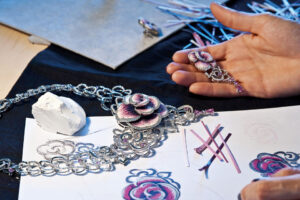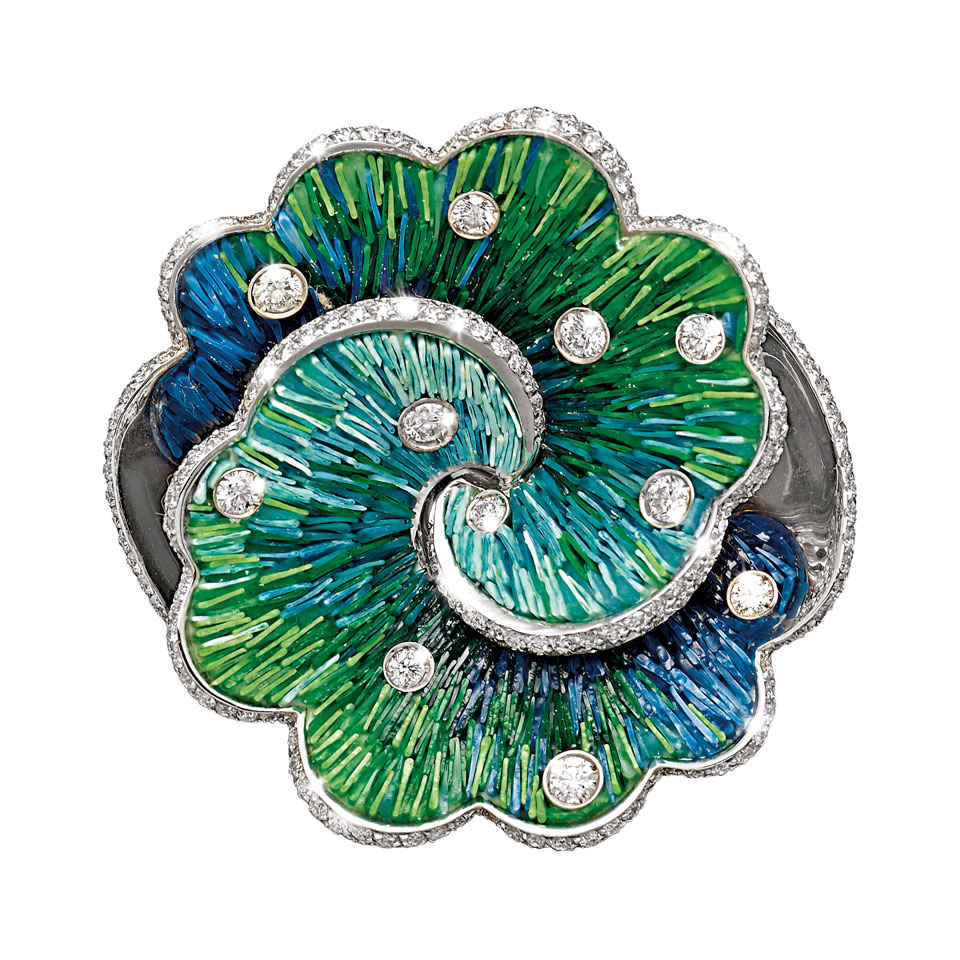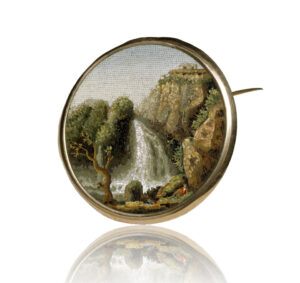“How did they make that?” It’s a common question that is asked the first time one sees micro-mosaic jewelry.
The astonished reaction is understandable. A square inch of micro-mosaic jewelry can have as many as 1,400 pieces of tesserae (a small piece of glass, stone, or tile) in just one square inch, and can shimmer in a dazzling variety of hues.

Elegance and movement burst from this convertible brooch/pendant from the Acanthus collection designed by Roger Thomas. Courtesy of SICIS Jewels.
Techniques for making tesserae micro-mosaic jewelry can vary, but a common one is melting glass, pulling it into thin rods, and cutting it into miniscule pieces. The tesserae can be so small that a microscope may be needed to assemble them.

Micro-mosaic jewelry from start to finish: A watercolor rendering of the piece is painted. Micro-mosaic jewelry making process from the Rose Carpet collection. Courtesy of SICIS Jewels.
The roots of micro-mosaic jewelry trace back to the mosaics of ancient Rome. During the Renaissance, the idea was refined by craftsmen in Florence and the Vatican who began developing the technique now known as micro-mosaic and adapted it to jewelry. Florentine craftsmen used the pietra-dura technique which incorporated gem materials like lapis and agate with marble instead of glass. They favored depictions of nature such as flowers, leaves, birds and fruit, and used micro-mosaics to ornament tables and chairs. Vatican craftsmen, on the other hand, used glass tesserae to make replicas of famous paintings that were displayed to replace fading originals.
Micro-mosaic jewelry came of age with the “Grand Tour” – an era when wealthy British, Germans, and Americans made pilgrimages to France and Italy to see the paintings of the old masters. These affluent tourists wanted mementos of their travels, and micro-mosaic jewelry of famous sites and scenes were beautiful keepsakes. Ancient ruins, pastoral scenes, and animals were popular themes.
The years 1810 to 1840 marked a golden age for micro-mosaic jewelry. But starting in the mid-1800s, high-quality workmanship of these pieces generally declined, as less-discriminating tourists were satisfied with pieces of lesser quality.
Creating a micro-mosaic is such a painstaking process that only a handful of boutiques still make high-end jewelry pieces. One such company is Ravenna-based SICIS Jewels and Brand Manager and GIA Graduate Gemologist Gioia Placuzzi shared thoughts on what it’s like to run a 21st-century company rooted in 18th-century workmanship:
“It takes a master craftsperson dozens of hours to complete a nano[micro]-mosaic dial or jewel. Each nano[micro]-tesserae is made entirely by hand. The mosaic pieces are artistically fitted together to create patterns and motifs following the designs of the artist. The results are minute, unique and unrepeatable works of art.”

A ring from the “Lles Jeux dues Contraires” collection from SICIS Jewels is an explosion of blues and greens glass tesserae, studded with diamonds and set in 18K white gold. Courtesy of SICIS Jewels.
Micro-mosaic jewelry might have been a historical footnote if not for the dedication of a new generation of craftspeople. Because of them, we can enjoy the magnificent fruits of their labors.
Main image Courtesy Creative Commons, © Herb Neufeld.
Custom Field: Array

